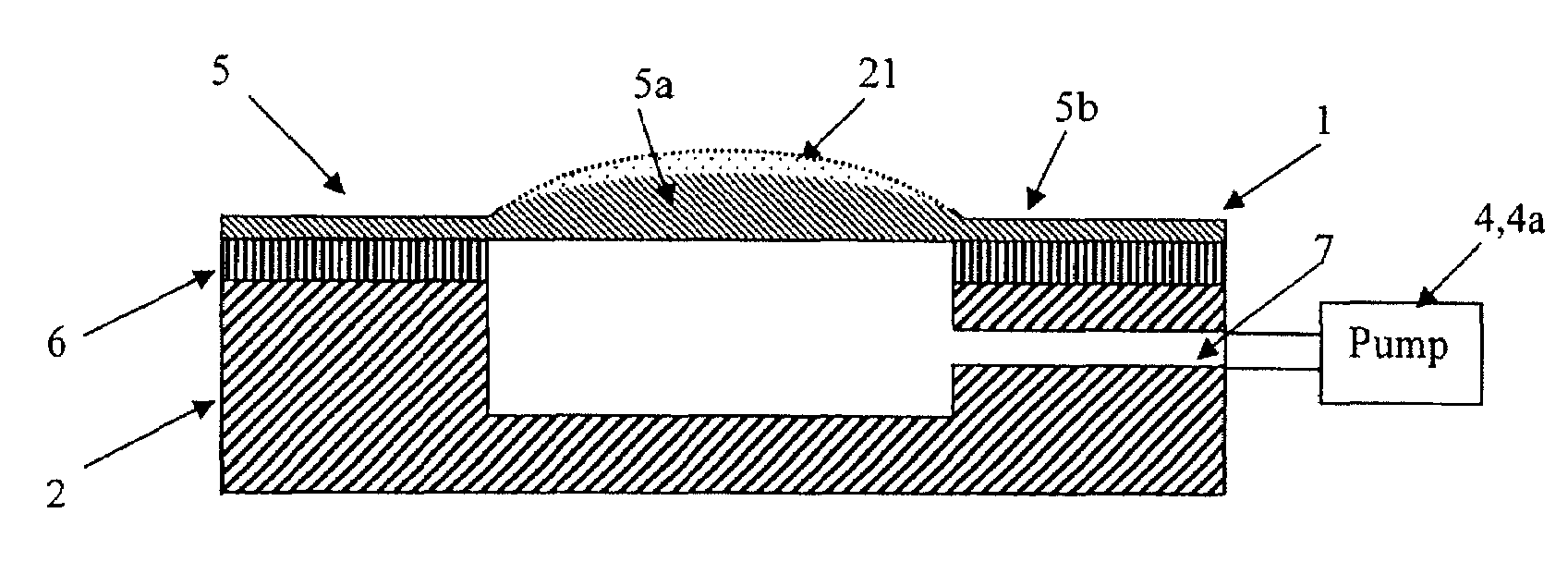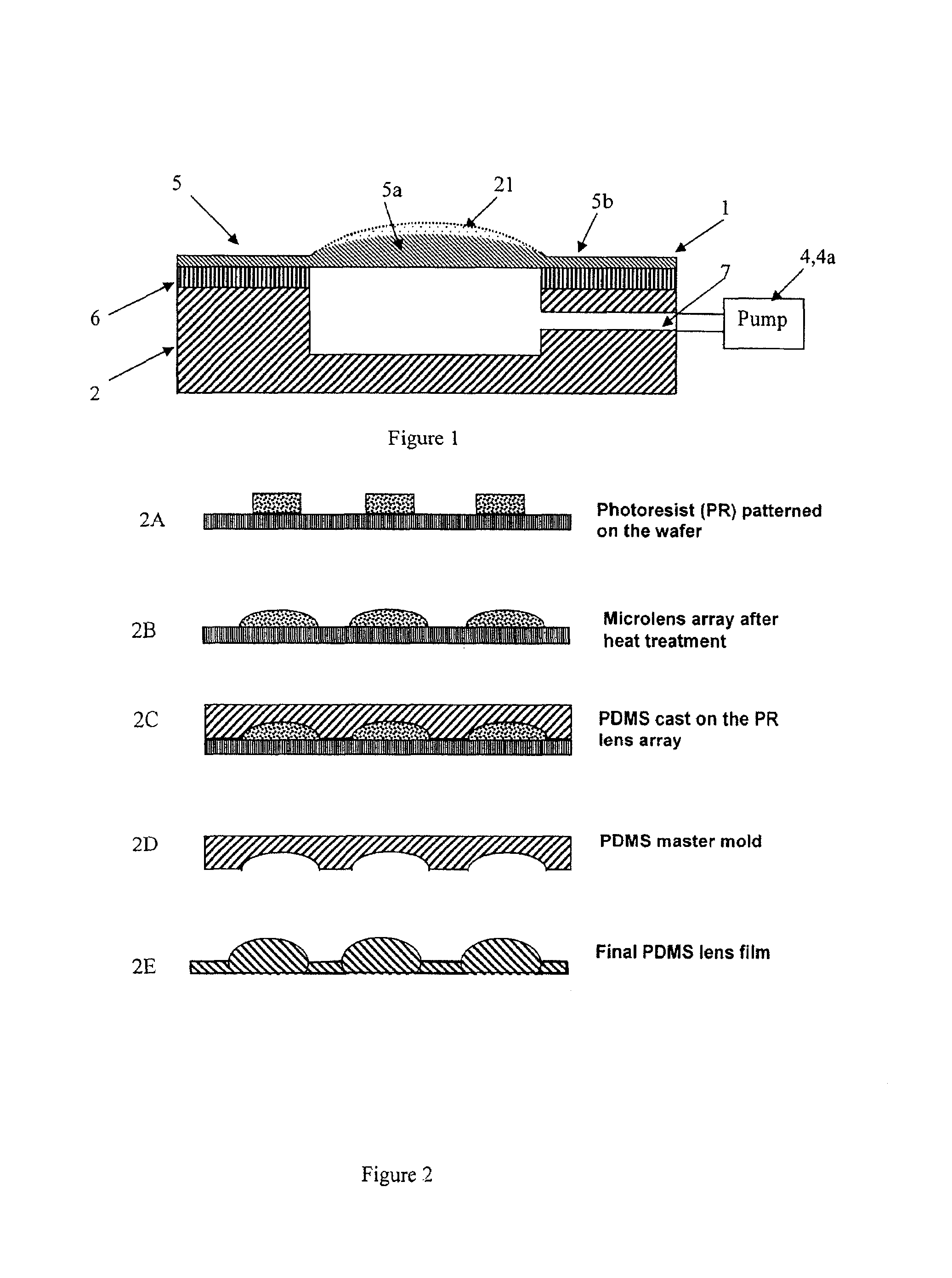Wide-angle variable focal length lens system
a lens system and variable focal length technology, applied in the field of flexible lens systems, can solve the problems of severe optical distortion, limited application of liquid crystal lenses, and difficulty in employing mechanical focusing mechanisms
- Summary
- Abstract
- Description
- Claims
- Application Information
AI Technical Summary
Problems solved by technology
Method used
Image
Examples
example 1
[0082]A flexible PDMS lens array was fabricated using the photoresist thermal treatment process described above in reference to FIG. 2. The photoresist material was AZ 100XT because the thickness of a single layer AZ 100XT can reach 50 μm. Two spin-coated photoresist layers are prepared which made the total thickness of the photoresist layer about 100 μm. Cylinders shapes are then formed in the photoresist using convention lithography techniques. These cylinders were thermally treated on a hot plate starting at 75° C. and gradually increasing the temperature. After reaching 120° C., the photoresist cylinders began to melt and reflow to form a spherical structure. The total reflow duration was 60 seconds. SEM images of the reflowed photoresist structures showed well formed 1500 μm diameter photoresist microlens structures which provided a mother mold for the microlens.
[0083]Next, the photoresist microstructure was transferred to a PDMS master by the casting method described above. PD...
example 2
[0093]A circular diaphragm actuator such as shown in FIG. 17 was designed. The actuator was made of transparent PDMS in order to not block light rays passing through the lens. Compliant, circular electrodes were fabricated on each side of PDMS film. The outside edge of the thin film was fixed tightly to prevent any movement. After applying the voltage on the electrodes, the thin film could be deformed in the central non-electrode part.
[0094]A mask for a circular actuator array was designed for a 4-inch substrate as suggested by FIG. 18. For a single actuation unit, the central transparent part was for a fabricated lens that was 3 mm in diameter. The compliant concentric circular electrodes were 3 mm from ID to OD. The actuator array was a 4×4 configuration of single units with connections to each other. After construction of the actuator devices, this pattern could be easily sectioned into small pieces for testing of either single unit actuators or different sized arrays of actuator...
example 3
[0108]Materials comprising various amount of (a) poly-dimethylsiloxane (PDMS) (Vinyl-addition silicone) as matrix, (b) Methacryloxypropyl Terminated PolyDimethylsiloxanes as photo-sensitive macromer, (c) a UV photoinitiator, 2-Hydroxy-2-methyl-1-phenyl-1-propanone (Ciba Darocur 1173), (d) a crosslinker (Gelest HMS-301), and (e) a Pt initiator for Vinyl-addition silicone cure (SIP6830.3), were made and tested. The first four components (a, b, c & d) were blended together initially. PDMS with the crosslinker HMS-301 was polymerized by addition of platinum catalyst as an initiator. PDMS was the polymeric matrix while the macromer and Darocur 1173 together formed the photo-sensitive macromer composition. Table 5 shows the samples' preparation and testing.
[0109]
TABLE 5Material composition for making GRIN lensesDiverging GRIN LensConverging GRIN LensPhotoinitiatorInitiatorMatrixMacromerMatrixMacromerCrosslinkerDarocur 1173Platinum CatalystPDV-0325SIB 1402.0PDV-1625SIB 1400.0HMS-301 (wt %)...
PUM
 Login to View More
Login to View More Abstract
Description
Claims
Application Information
 Login to View More
Login to View More - R&D
- Intellectual Property
- Life Sciences
- Materials
- Tech Scout
- Unparalleled Data Quality
- Higher Quality Content
- 60% Fewer Hallucinations
Browse by: Latest US Patents, China's latest patents, Technical Efficacy Thesaurus, Application Domain, Technology Topic, Popular Technical Reports.
© 2025 PatSnap. All rights reserved.Legal|Privacy policy|Modern Slavery Act Transparency Statement|Sitemap|About US| Contact US: help@patsnap.com



